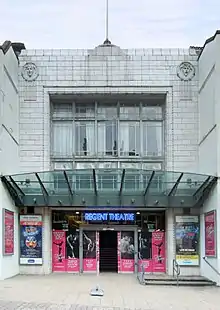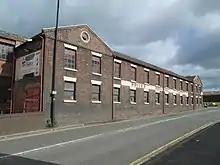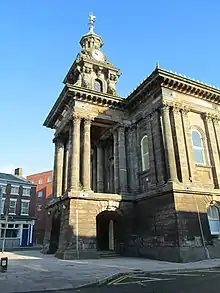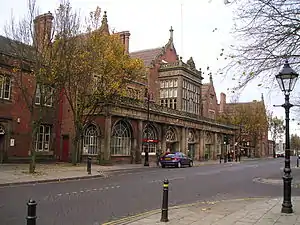Grade II* listed buildings in Stoke-on-Trent
Stoke-on-Trent is a city located in Staffordshire, England. The city is a linear conurbation of six constituent towns (Burslem, Fenton, Longton, Tunstall, Stoke-upon-Trent and Hanley, with the latter being regarded as the city centre). Stoke-on-Trent is considered to be the home of the pottery industry in England and is commonly known as the Potteries. Formerly a primarily industrial conurbation, it is now a centre for service industries and distribution centres.

There are over 20,000 Grade II* listed buildings in England and this page is a list of these buildings in the city of Stoke-on-Trent. There are sixteen buildings or structures that have been listed by the Secretary of State for Culture, Olympics, Media and Sport as Grade II*, which signifies "particularly important buildings of more than special interest".
In the United Kingdom, the term "listed building" refers to a building or other structure officially designated as being of special architectural, historical or cultural significance. These buildings are in three grades: Grade I consists of buildings of outstanding architectural or historical interest; Grade II* includes particularly significant buildings of more than local interest. Buildings in England are listed on recommendations provided by English Heritage, which also determines the grading.[1]
Listed buildings and structures
| Name | Location | Type | Completed [note 1] | Date designated | Grid ref.[note 2] Geo-coordinates |
Entry number [note 3] | Image |
|---|---|---|---|---|---|---|---|
| Bethesda Methodist Chapel | Hanley, City of Stoke-on-Trent | Methodist Chapel | 1819 | 19 April 1972 | SJ8822847351 53°01′24″N 2°10′37″W |
1195821 | |
| Former Church of St John the Evangelist | Hanley, City of Stoke-on-Trent | Former Church | 1788-90 | 2 October 1951 | SJ8835947868 53°01′41″N 2°10′30″W |
1210680 |  Former Church of St John the Evangelist |
| Church of the Holy Trinity | Hartshill, City of Stoke-on-Trent | Church | 1842 | 19 April 1972 | 53°00′35″N 2°12′07″W | 1195800 |  Church of the Holy Trinity |
| Etruscan Bone Mill | Etruria, City of Stoke-on-Trent | Bone and flint mill | C20 | 15 March 1993 | SJ8721546825 53°01′07″N 2°11′31″W |
1195818 | |
| Ford Green Hall and Attached Wall and Dovecote | Smallthorne, City of Stoke-on-Trent | Farmhouse | Late 16th century | 2 October 1951 | SJ8873950860 53°03′18″N 2°10′10″W |
1220313 | |
| Former Gladstone and Park Place (Roslyn) Works | Longton, City of Stoke-on-Trent | Pottery works | c1860 and later | 19 April 1972 | SJ9129543256 52°59′12″N 2°07′52″W |
1195854 | |
| Former Wedgwood Institute (public Library) | Burslem, City of Stoke-on-Trent | Art School | 1869 | 19 April 1972 | SJ8686649748 53°02′41″N 2°11′50″W |
1195840 |  Former Wedgwood Institute (public Library) |
| Middleport Pottery (Burgess and Leigh) | Middleport, City of Stoke-on-Trent | Pottery works with bottle oven | 1888-9 | 20 August 1979 | SJ8604849321 53°02′28″N 2°12′34″W |
1297939 | |
| North Staffordshire Hotel | Stoke-upon-Trent, City of Stoke-on-Trent | Hotel | 1848 | 19 April 1972 | SJ8800745691 53°00′30″N 2°10′49″W |
1290251 | |
| Odeon Cinema (now Regent Theatre) | Hanley, City of Stoke-on-Trent | Cinema/theatre | 1929 | 30 November 1989 | SJ8825447476 53°01′28″N 2°10′36″W |
1195837 |  Odeon Cinema (now Regent Theatre) |
| Old Town Hall | Burslem, City of Stoke-on-Trent | Town Hall | 1854 | 2 October 1951 | SJ8683249844 53°02′45″N 2°11′52″W |
1195811 | |
| Pithead Baths and Canteen at Chatterley Whitfield Colliery | Whitfield, City of Stoke-on-Trent | Colliery | 1936-1937 | 23 February 1994 | SJ8835853428 53°04′41″N 2°10′31″W |
1260223 |  Pithead Baths and Canteen at Chatterley Whitfield Colliery |
| Price and Kensington Teapot Works | Longton, City of Stoke-on-Trent | Pottery works | Early 19th century | 20 August 1979 | SJ8577749728 53°02′41″N 2°12′49″W |
1290799 |  Price and Kensington Teapot Works |
| Stoke-on-Trent railway station | Stoke-upon-Trent, City of Stoke-on-Trent | Railway Station | 1847 | 19 April 1972 | SJ8796445658 53°00′29″N 2°10′51″W |
1210928 | |
| The Round House | Etruria, City of Stoke-on-Trent | Pottery Works | c. 1769 | 19 April 1972 | SJ8690947305 53°01′22″N 2°11′48″W |
1291071 | .jpg.webp) The Round House |
| 1 Moorland Road | Burslem, City of Stoke-on-Trent | House | 1751 | 2 October 1951 | SJ8692349861 53°02′45″N 2°11′47″W |
1220792 |  |
Notes
- The date given is the date used by Historic England as significant for the initial building or that of an important part in the structure's description.
- Sometimes known as OSGB36, the grid reference is based on the British national grid reference system used by the Ordnance Survey.
- The "List Entry Number" is a unique number assigned to each listed building and scheduled monument by Historic England.
External links
![]() Media related to Grade II* listed buildings in Staffordshire at Wikimedia Commons
Media related to Grade II* listed buildings in Staffordshire at Wikimedia Commons
- "Listed Buildings", english-heritage.org.uk, English Heritage, retrieved 19 February 2011







